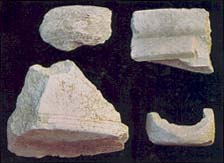Image Details

Courtesy Sepphoris Regional Project/Photo by J. L. Reed
A Jewish presence in Sepphoris is clearly shown by stone fragments found throughout the city’s first-century C.E. residential section. The fragments are the scattered remains of stone vessels, which once were used to store pure water intended for ritual washing. Ancient Jews favored such vessels because stone—unlike pottery, metal and glass—was not subject to ritual impurity. Authors Chancey and Meyers consider these fragments to be one of three key “ethnic markers” indicating that first-century C.E. Sepphoris was predominantly Jewish, not Hellenistic. The other two markers are the paucity of pig bones dating to the Roman period and the presence of numerous mikva’ot (Jewish ritual baths) in the city.
